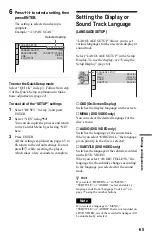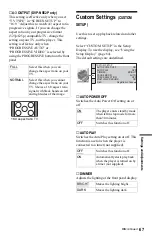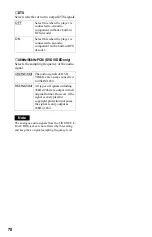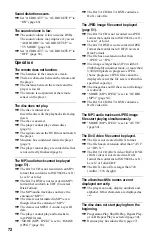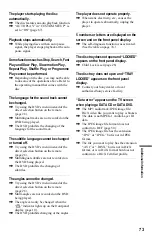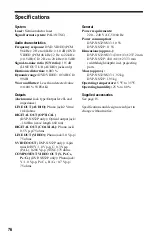
75
Additional Infor
m
ation
DVD VIDEO (page 5)
A disc that contains up to 8 hours of moving
pictures even though its diameter is the same
as a CD.
The data capacity of a single-layer and single-
sided DVD is 4.7 GB (Giga Byte), which is 7
times that of a CD. The data capacity of a
double-layer and single-sided DVD is 8.5
GB, a single-layer and double-sided DVD is
9.4 GB, and double-layer and double-sided
DVD is 17 GB.
The picture data uses the MPEG 2 format, a
worldwide standard of digital compression
technology. The picture data is compressed to
about 1/40 (average) of its original size. The
DVD also uses a variable rate coding
technology that changes the data to be
allocated according to the status of the
picture. Audio information is recorded in a
multi-channel format, such as Dolby Digital,
allowing you to enjoy a more realistic audio
presence.
Furthermore, various advanced functions
such as the multi-angle, multilingual, and
Parental Control functions are provided with
the DVD.
A DVD-RW is a recordable and rewritable
disc that is the same size as a DVD VIDEO.
The DVD-RW has two different modes: VR
mode and Video mode. DVD-RWs created in
Video mode have the same format as a DVD
VIDEO, while discs created in VR (Video
Recording) mode allow the contents to be
programmed or edited.
A DVD+RW (plus RW) is a recordable and
rewritable disc. DVD+RWs use a recording
format that is comparable to the DVD VIDEO
format.
A JPEG image recorded on a DATA CD/
DATA DVD or a DivX video on a DATA
CD/DATA DVD (“File” is an exclusive
definition for this player). A single file
consist of a single image or video.
Film based software, Video based
software (page 19)
DVDs can be classified as Film based or
Video based software. Film based DVDs
contain the same images (24 frames per
second) that are shown at movie theatres.
Video based DVDs, such as television
dramas or sit-coms, displays images at 25
frames/60 fields (30 frames/60 fields) per
second.
International standard coding system used to
compress audio digital signals authorized by
ISO/IEC. MPEG 1 conforms to up to 2-
channel stereo. MPEG 2, used on DVDs,
conforms to up to 7.1-channel surround.
Normal (Interlace) format (page 18)
Normal (Interlace) format shows every other
line of an image as a single “field” and is the
standard method for displaying images on
television. The even number field shows the
even numbered lines of an image, and the odd
numbered field shows the odd numbered lines
of an image.
Progressive format (page 18)
Compared to the Interlace format that
alternately shows every other line of an image
(field) to create one frame, the Progressive
format shows the entire image at once as a
single frame. This means that while the
Interlace format can show 25 or 30 frames
(50-60 fields) in one second, the Progressive
format can show 50-60 frames in one second.
The overall picture quality increases and still
images, text, and horizontal lines appear
sharper. This player is compatible with the
525 or 625 progressive format.
Progressive JPEG
Progressive JPEGs are used mostly on the
internet. They are different from other JPEGs
in that they “fade in” gradually instead of
being drawn from top to bottom when
displayed on a browser. This lets you view the
image while it is being downloaded.
The longest section of a picture or music
feature on a DVD, movie, etc., in video
software, or the entire album in audio
software.





